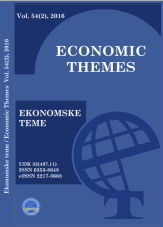Economic Themes (2016) 54 (2) 1, 177-194
Dragoslava Sredojević, Slobodan Cvetanović, Gorica Bošković
Abstract: The aim of the research in this paper is to analyse the issue of the treatment of the category of technological changes within the main aspects of economic growth theory. The analysis of the key positions of neoclassical theory (Solow), endogenous approach (Romer), and evolutionary growth theory (Freeman) advocates has pointed to the conclusion that these approaches agree on the fact that the category of technological changes is a key generator of economic growth. Neoclassicists were the first to explicitly analyse the category of technological changes in growth theory. They exerted a strong influence on a large number of governments to allocate significant funds for scientific and research development, to stimulate the creation and diffusion of innovation. Supporters of endogenous theory also see the category of technological changes as a key driver of economic growth. Unlike neoclassicists, they emphasise the importance of externalities, in the form of technological spillover and research and development activities, for the creation and diffusion of innovation. Finally, evolutionary and institutional economists explore the category of technological changes inseparably from the economic and social environment in which they are created and diffused. Recommendations of this research can be of particular use to economic growth and development policy makers in the knowledge economy, whose basic and substantial feature is the so-called fourth industrial revolution.
Keywords: technological changes; economic growth; economic growth theory; neoclassical theory; endogenous growth theory; evolutionary growth theory
TECHNOLOGICAL CHANGES IN ECONOMIC GROWTH THEORY: NEOCLASSICAL, ENDOGENOUS, AND EVOLUTIONARY-INSTITUTIONAL APPROACH
Dragoslava Sredojević, Slobodan Cvetanović, Gorica Bošković
Abstract: The aim of the research in this paper is to analyse the issue of the treatment of the category of technological changes within the main aspects of economic growth theory. The analysis of the key positions of neoclassical theory (Solow), endogenous approach (Romer), and evolutionary growth theory (Freeman) advocates has pointed to the conclusion that these approaches agree on the fact that the category of technological changes is a key generator of economic growth. Neoclassicists were the first to explicitly analyse the category of technological changes in growth theory. They exerted a strong influence on a large number of governments to allocate significant funds for scientific and research development, to stimulate the creation and diffusion of innovation. Supporters of endogenous theory also see the category of technological changes as a key driver of economic growth. Unlike neoclassicists, they emphasise the importance of externalities, in the form of technological spillover and research and development activities, for the creation and diffusion of innovation. Finally, evolutionary and institutional economists explore the category of technological changes inseparably from the economic and social environment in which they are created and diffused. Recommendations of this research can be of particular use to economic growth and development policy makers in the knowledge economy, whose basic and substantial feature is the so-called fourth industrial revolution.
Keywords: technological changes; economic growth; economic growth theory; neoclassical theory; endogenous growth theory; evolutionary growth theory

